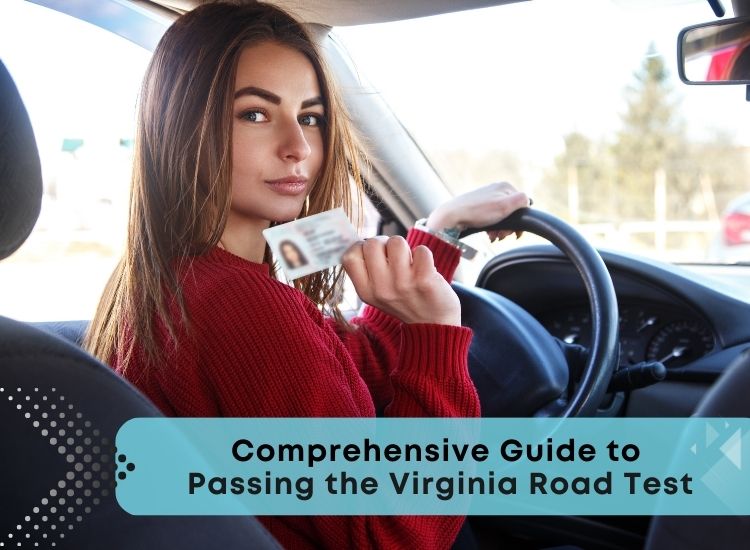Step to pass DMV VA Road test
Preparing for the DMV Virginia road test can be an intimidating prospect for many new drivers. This pivotal examination determines your ability to drive safely and responsibly on the roads, making it a crucial step toward obtaining your driver’s license. To maximize your chances of success, it is crucial to approach the test with confidence and thorough preparation.
In this guide, we will provide you with a comprehensive set of essential tips to help you excel in the DMV Virginia road test. These tips range from practicing in low-traffic areas to understanding traffic signs and demonstrating attentive driving skills. By following these recommendations, you will gain the knowledge and confidence necessary to ace your road test. Let’s delve into these valuable tips and pave the way for a successful road test experience.
Step to pass DMV VA Road test
1. Before you take DMV Virginia road test, you should practice and practice wherever possible in a relatively empty area. Make sure you have a qualified driver sitting with you to make sure you’re doing the right thing.
2. Familiarize yourself with traffic signs, hand gestures and traffic times of your area beforehand.
3. Once in the car, adjust the seat to fit your body height and style.
4.Get your car prepared. Make sure you have the vehicle’s signing up, that all front lights and signs work and there are no breaks in the windows. It also allows if the car is elegant within.
5. Make sure you reach least 10 moments before your consultation. Carry your finished and finalized Motorist’s Log, Individuals Ed document, generating time with an trainer document, and your students allow. Also bring your public protection card and beginning record for recognition requirements for your DMV VA road test.
6. Get in the car with the generating examiner. Rest. You should have already Modified your chair, decorative mirrors, and rim with your trainer, so no need to modify them! Ask any concerns that you have before analyze and in the analyze if you are puzzled. The generating examiner will be grateful to response them.
7. Get your car ready. Make sure you have the car’s registration, that all headlights and indicators work and there are no breaks in the windshield. It also helps if the car is neat and clean inside.
8. Make sure you arrive to DMV as early as you can. (I remember I had to wait for over 2 hour to get road test) Don’t forget to bring your Virginia learners permit.
9. Get in the car with the driving examiner. Try to Relax. You should have already adjusted your seat, mirrors, and steering wheel with your instructor, so no need to adjust them! Ask any questions that you have prior to the test and in the test if you are confused. The driving examiner will be glad to answer them.
10. Stop at all stop signs. Use the indicator when necessary. Keep your eyes on the road, gazing to the right and left when going through cross roads and look in center mirror every 4 seconds to see what’s happening behind you.
11. At all times drive try to stay within the speed limit, not necessarily the speed limit, as this will show the examiner you are confident on your road test
12. Changing lanes . Use your rear-view mirrors and make sure by quickly turning your head and glancing over your shoulder to ensure the way is clear. Look over your shoulder even if, you think you can see the blind spot. It sounds ridiculous but examiners specifically look to see whether people are glancing over their shoulder or just using the mirrors. Not glancing over the shoulder is a common mistake that a lot of people make and these people always have to come back to take the Virginia road test again.
13. Additionally show the examiner that you pay attention on traffic around you.
14. Another essential tip that many people do not think of is the cell phone, this would not be a good time to response your cell phone, you should turn it off before you taking a road test.
Successfully navigating the DMV Virginia road test is a crucial step towards obtaining your driver’s license. By incorporating the essential tips provided in this guide, you can significantly increase your chances of acing the test.
Remember to practice in low-traffic areas, familiarize yourself with traffic signs and gestures, and maintain a calm and confident demeanor during the examination. Pay attention to the details, such as adjusting your seat and mirrors, ensuring your vehicle is in good condition, and following traffic regulations.
Demonstrating attentiveness by keeping your focus on the road, using indicators appropriately and checking blind spots when changing lanes will impress the driving examiner. Additionally, arriving early, bringing all necessary documents and minimizing distractions like cell phones are crucial for a smooth test experience. With these tips in mind, you are well-prepared to excel in the DMV Virginia road test and embark on a safe and responsible driving journey. Best of luck!
Frequently Asked Questions
What is the purpose of the DMV Virginia road test?
The purpose of the DMV Virginia road test is to assess an individual’s ability to drive safely and responsibly, determining their readiness to obtain a driver’s license.
Why is practicing in empty areas recommended before the road test?
Practicing in empty areas allows new drivers to gain confidence, practice maneuvers, and become familiar with the basic controls of the vehicle without the pressure of heavy traffic.
What should drivers do to prepare for the road test regarding traffic signs?
Drivers should familiarize themselves with traffic signs to understand their meanings and be able to respond appropriately during the road test.
How can drivers ensure their vehicle is prepared for the road test?
Drivers should check that all front lights and indicators are functioning properly, there are no cracks in the windshield, and the car’s registration is up to date.
Why is it important to arrive early for the road test?
Arriving early ensures that there is enough time to complete any necessary paperwork and mentally prepare for the test without feeling rushed.
What should drivers bring with them for the road test?
Drivers should bring their completed and signed Motorist’s Log, Driver’s Education document, driving time with an instructor document, learner’s permit, and identification documents such as a social security card and birth certificate.
Why is it crucial to relax during the road test?
Remaining calm and relaxed during the road test helps drivers to make better decisions, demonstrate confidence, and perform their driving skills effectively.
Why is it important to check blind spots when changing lanes?
Checking blind spots by glancing over your shoulder ensures that there are no vehicles in your blind spots that may lead to accidents during lane changes.
What is the significance of turning off cell phones before the road test?
Turning off cell phones eliminates distractions, allowing drivers to focus solely on the road and the instructions given during the road test.
Resource 1: DMV Virginia – http://www.dmvNOW.com







